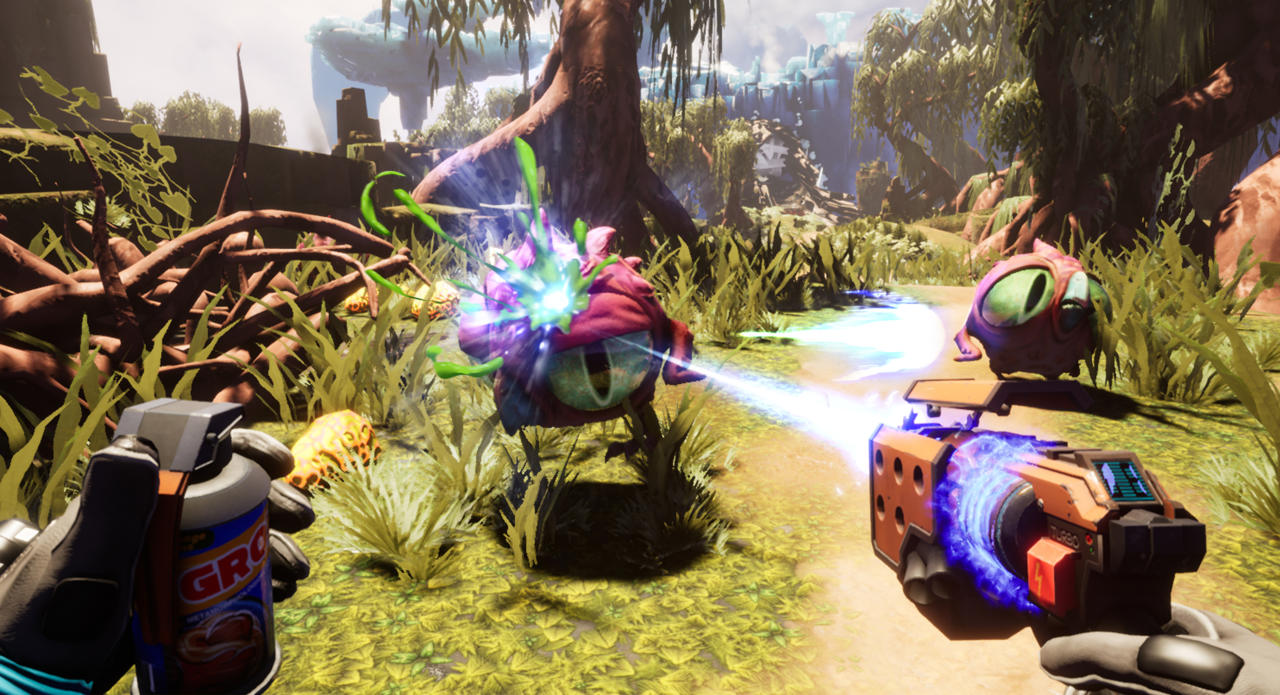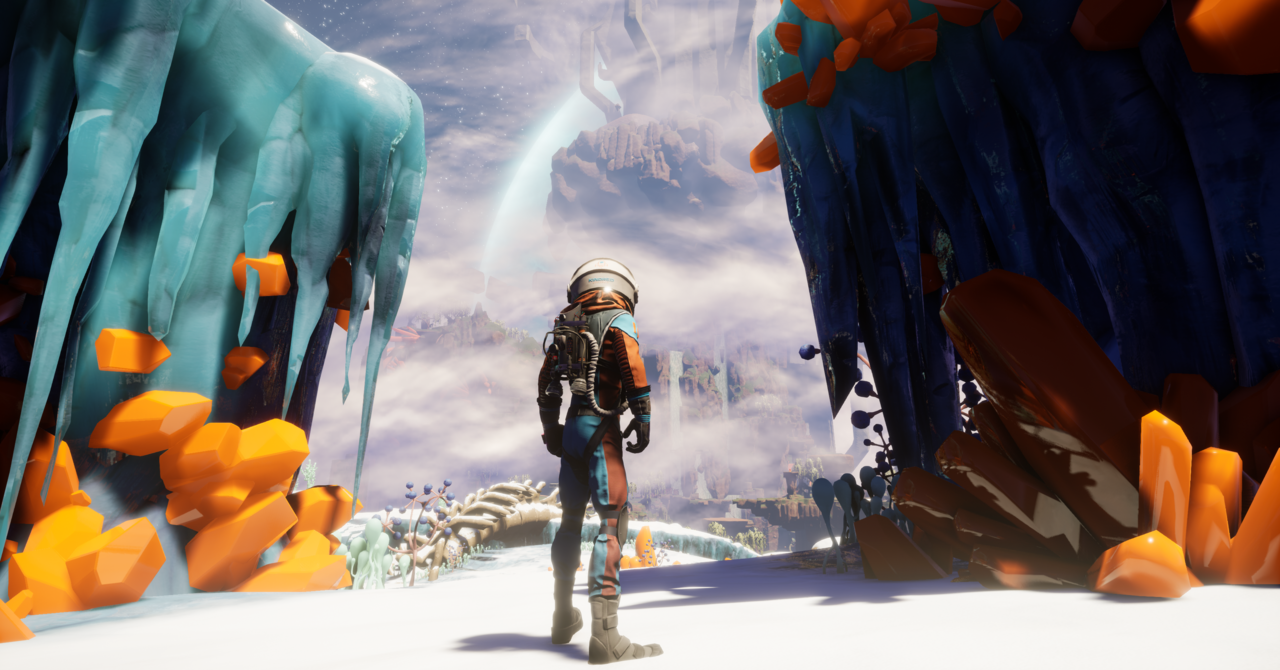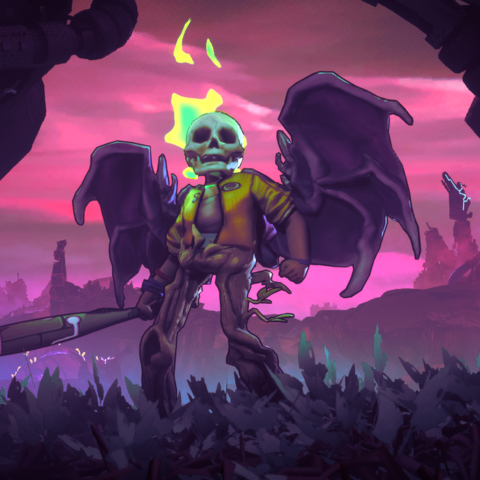Revealed at The Game Awards 2018, Journey to the Savage Planet takes a decidedly more strange and self-aware approach to the premise of the lone space adventurer exploring a distant world. Instead of seeking knowledge and charting new areas of the universe for the betterment of humanity, it's your job as an interstellar adventurer to make way for the inevitable push of capitalism by prepping the planet for your employer--a mid-tier corporation that has an endless flow of products to sell.
We spent some time with Journey to the Savage Planet during GDC 2019 and spoke with Typhoon Studios co-founder and creative director Alex Hutchinson about the developer's approach to the familiar premise, why he's proud the game features no procedurally generated content, and how players will always be within reach of consumerist tendencies, even in the furthest reaches of space.

Playing as an unnamed planetary settler for Kindred Aerospace--the fourth-best interstellar corporation in the universe--you'll explore a distant planet housing strange wildlife and plentiful resources. With the intent on making the planet ready for colonization, you'll quickly find that the creatures of the planet are more than capable of defending their territory from invaders. To make things more complicated, the planet possesses signs of intelligent life, and prominently features some ominous ancient ruins hinting at something hidden deep within the planet. In order to complete your lonely mission, you'll need to collect as much data as you can and uncover the secrets of the ruins, and this is all while enduring constant advertisements for Kindred products.
In a similar vein to the adventurous jaunts found in No Man's Sky, the key to accomplishing your goals in Savage Planet is to explore as much as you can, scan everything in sight, and collect resources. But in contrast to the scale and breadth of procedurally generated content found in the former game, Typhoon Studios' self-aware take on the space-adventure is set entirely on one planet, allowing you to get acquainted with all the bizarre sights found within. Your only safe haven on the planet is your makeshift base. If you die, a 3D-printed copy of yourself will respawn here, allowing you to continue your mission.
Typhoon Studio worked to present a setting that shows personality and nuance, Hutchinson said, setting Savage Planet apart from other games that rely heavily on tech that creates content on the fly.

"It's kind of like we're a hipster game, we made all of the content in-game by hand," said Hutchinson while explaining Typhoon's approach to world design. "Personally, I don't think anything made by an algorithm is worth looking at. The meaning of anything creative for me is why you did it and how you did it. If no one did, then I don't really find it that meaningful. It's like you're missing the point by relying on that technology too much. Also, we made a very funny game, and there really aren't a lot of games like that out there. I remember growing up with games like the Super Nintendo and the Amiga 500, and playing these new games you'd see these bright blue skies, and it had an optimistic outlook in them where you would actually like to be in those cool worlds. That was really attractive to me, and it's something that's somewhat absent now."
In keeping with those retro roots, Savage Planet has a lot in common with games like Metroid and Castlevania, focusing on the exploration of an interconnected environment. Over the course of your expedition, you'll gradually find some rare materials to upgrade your suit and weaponry. With the planet divided into four distinct biomes, each area requires certain gadgets to traverse. For instance, the grappling hook upgrade can open up new shortcuts and sections of the planet, and is surprisingly useful when trying to evade certain enemies.
Just when you think you've gotten used to the strange wildlife, such as non-hostile creatures that howl with an ear-piercing screech if provoked, you'll encounter some of the more dangerous critters. During the demo, we came across a larger beast that could fire out mortar strikes from its back.
Personally, I don't think anything made by an algorithm is worth looking at. The meaning of anything creative for me is why you did it and how you did it.
One of the more interesting twists on the larger plot is that your character is an extension of the larger corporation that's come to colonize the planet. Though the game doesn't outright refer to you as a colonizer or an invader, it's not hard to see that you're clearly encroaching upon territory that isn't yours, especially when it's your job to disrupt the environment for a company that can just as easily clone you as it tries to sell you on more of its products. With no means of two-way communication, your only link back to civilization is with constant live-action advertisements that mimic late-night '90s infomercials. These ads all praise the corporation's mid-tier achievements while hawking bizarre goods that are mostly useless for your mission--even more so in the grander scheme of trying to find ancient life on the planet.
"We often joke that you're basically coming to this alien world to ruin it," said Hutchinson. "But everything we've placed in this game has a point. When a game says 'you're on an adventure!' it's usually not for no reason, there is a broader point to be made, a payoff. You have your goal and your core missions to find and accomplish, and you can accomplish those goals at any time in your own way. But also, we're going to bombard you with weird advertisements along the way."

What I found most interesting about Journey to the Savage Planet is how it managed to blend satire with the experience of an isolating exploration game, which felt surprisingly more intimate than expected. That feeling of isolation is often punctuated with the obnoxious live-action advertisements, which are the closest connection you have to civilization and a friendly face. Though it's still a ways out from launch, planned for a Q1 2020 release, Typhoon's new game seems to be striking a particular tone that aims to be more thoughtful with the pulpy premise than it initially lets on.





